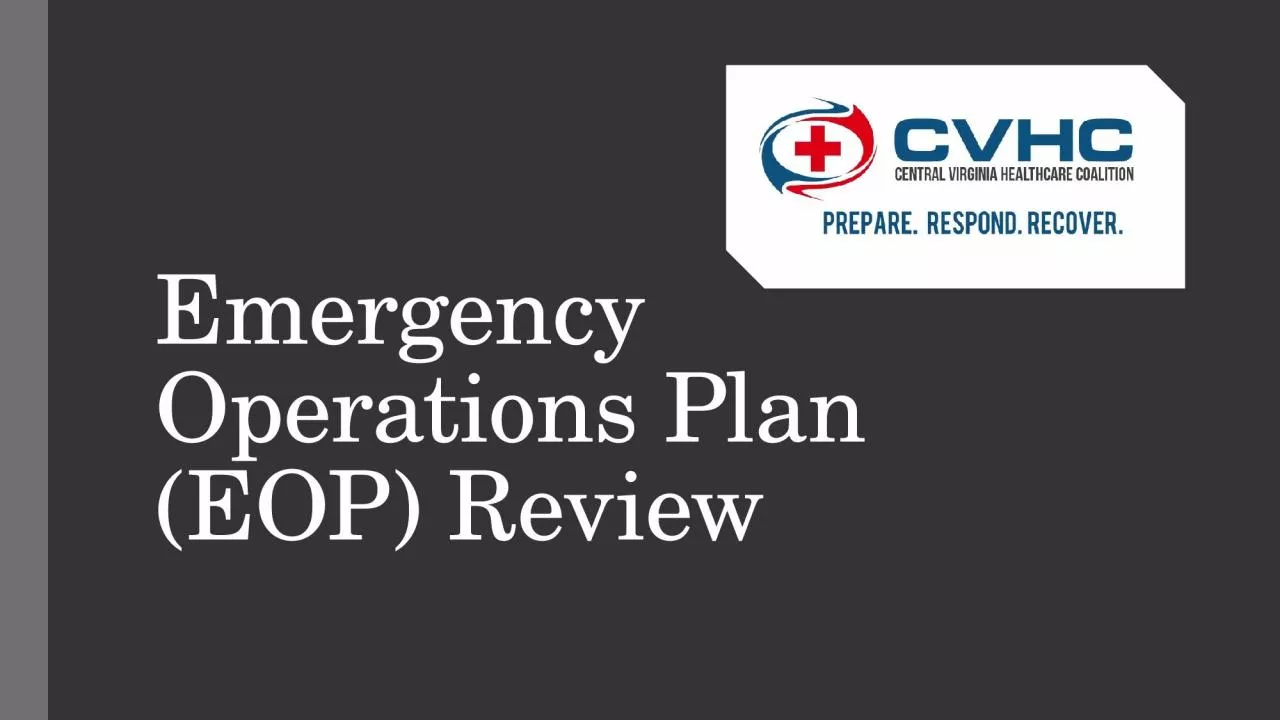

Objectives Review Healthcare Preparedness Program Structure Recognize Healthcare Preparedness amp Response Capabilities Detail the CMS Emergency Preparedness Rule Understand accreditation requirements of the EOP ID: 1031441
Download Presentation The PPT/PDF document "Emergency Operations Plan (EOP) Review" is the property of its rightful owner. Permission is granted to download and print the materials on this web site for personal, non-commercial use only, and to display it on your personal computer provided you do not modify the materials and that you retain all copyright notices contained in the materials. By downloading content from our website, you accept the terms of this agreement.
1. Emergency Operations Plan (EOP) Review
2. Objectives:Review Healthcare Preparedness Program StructureRecognize Healthcare Preparedness & Response CapabilitiesDetail the CMS Emergency Preparedness RuleUnderstand accreditation requirements of the EOP
3. Things to Remember…EOPs Organize into one manual and tab each sectionHave a limited number of hard copiesHave a distribution pageHave a changes pageUse job aids and checklists that coincide with each specific type of incident identified in the risk assessmentIt should be specific to your facility
4. CMS Emergency Preparedness RuleOverview and impacts
5. CMS ComplianceCenters for Medicare & Medicaid ServicesConditions of Participation (CoPs) and Conditions for Coverage (CfCs) Health and safety regulationsMust be met by all Medicare & Medicaid-participating providers and suppliers.Conditions of reimbursement.The EP Rule’s purpose is to:Enhance patient safety during an emergency.Enhance healthcare delivery system resilience.
6. Who is Impacted?HospitalsReligious Nonmedical Health Care InstitutionsAmbulatory Surgical CentersHospicesPsychiatric Residential Treatment FacilitiesAll-Inclusive Care for the Elderly (PACE)Transplant CentersLong-Term Care (LTC) FacilitiesIntermediate Care Facilities for Intellectually DisabledHome Health AgenciesOutpatient RehabCritical Access HospitalsCommunity Mental Health CentersOrgan Procurement OrganizationsRural Health ClinicsEnd Stage Renal Disease Facilities (Dialysis)
7. Goal of EP UpdateGoal of EP Rule Updates:Address healthcare system gaps.Establish consistent emergency preparedness practices across provider & supplier types.Encourage emergency coordination with region & localities.
8. Four Requirements Apply to All Provider Types
9. Risk Assessment & PlanningPerform risk assessment using an “all-hazards” approach.Update annuallyRisk Assessment to include:Care-related emergenciesEquipment and Power FailuresCommunications interruption, including cyberattacksLoss of all/portion of facility or clinical supplies
10. Risk Assessment, contd.Develop an emergency plan (updated annually) based on the risk assessment.Key elements:Integrated approach- demonstrate ability to address a broad range of hazards.Addresses shelter-in-place/evacuationBusiness Continuity & Continuity of CareCollaboration with local/regional/state Emergency Mgmt
11. Policies & ProceduresDevelop and implement policies and procedures based on the emergency plan and risk assessment.Policies and procedures must address a range of issues including subsistence needs, evacuation plans, procedures for sheltering in place, mutual aid, patient tracking, medical records, etc.Review and update policies and procedures at least annually.
12. AssumptionsScenariosSingle Facility / Isolated Incident (e.g., Fire, Loss of Emergency Power);Single Facility / Local or Area-wide Incident (e.g., Flooding, Ice Storm, Blizzard); Multiple Facility / Statewide or Regional Incident (e.g., Derecho, Hurricane, Tornado).
13. Incident Management BackgroundCMS EP RuleInternal Emergency Operations PlanNational Preparedness SystemNIMSNursing Home Incident Command SystemLTC-MAPPg. 7-Internal Emergency Operations Plan
14.
15.
16.
17.
18.
19.
20.
21.
22.
23.
24. Communication PlanDevelop a communication plan that complies with both Federal and State laws.Coordinate patient care within the facility, across health care providers, and with emergency management systems.Review and update plan annually.
25. Communication Plan, contd.Communications Plan must include:Names/Contact info for stakeholders Primary and alternate means of communicating with stakeholdersProcess/method for sharing medical records and patient informationProcess for sharing logistical information such as census, needs, and ability to provide assistance to other facilities.
26. Training & Testing ProgramDevelop and maintain training and testing programs. Facilities encouraged by CMS to engage local/state EM and health care coalitions to meet this requirement.Training program must include:Initial EP training for new & existing staff, individuals providing services on behalf of facility, and volunteers (consistent with their expected roles).Documentation of training activitiesProvision of annual update training for all staff.
27. Training & Testing ProgramTesting (Exercise) Program must include:Annual exercises to test emergency plansTabletop Exercise (recommends HSEEP, but not required)Community-based Full-Scale ExerciseIf full-scale with community not possible, document why and conduct individual facility-based exercise.Facility is exempt from full-scale requirement for 1 year if an actual or man-made emergency results in activation of the emergency plan.Documentation required
28. Facility-Specific RulesOutpatient providers not required to have policies on provision of subsistence needs.Home Health Agencies and hospices required to inform local EMA of patients in need of evacuation during an emergency.Long-Term Care and residential Psych facilities must share emergency plan information with residents & their family members.
29. Facility-Specific RulesOutpatient providers not required to have policies on provision of subsistence needs.Home Health Agencies and hospices required to inform local EMA of patients in need of evacuation during an emergency.Long-Term Care and residential Psych facilities must share emergency plan information with residents & their family members. Additional requirements for Emergency Power and Standby Systems for hospitals, critical access hospitals, and Long-Term Care
30. Expectations for Emergency ManagementNOT local EMA’s responsibility to ensure or assist with successful certification.Local EM’s CAN expect entities to contact them about:Obtaining copies of jurisdictional HVA or THIRAPlan/policy integrationEngaging in training/exercise opportunitiesBasic information on emergency preparedness and healthcare system preparedness
31. Expectations for Emergency ManagementEMAs are not required to certify plans!EMAs (collaborate with CVEMA?) should develop a standard level of service for requesting facilities:Standard One-PagerSet platform for relationships and collaboration despite limited resourcesEncourage collaboration with Public Health and Healthcare Coalition
32. Questions?Pete SvobodaMVP CoordinatorCentral Virginia Healthcare Coalitionpete.svoboda@central-region.orgRHCC 24/7 Activation: 1-800-276-0683